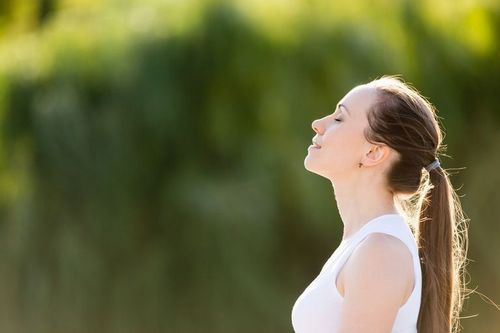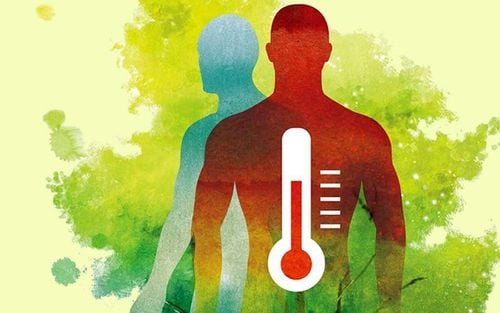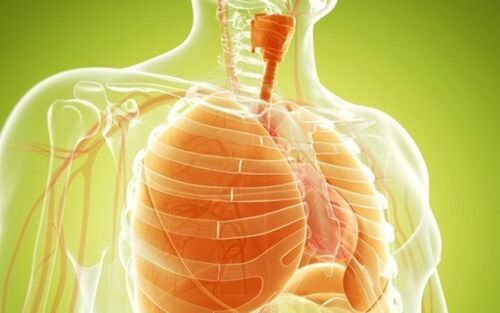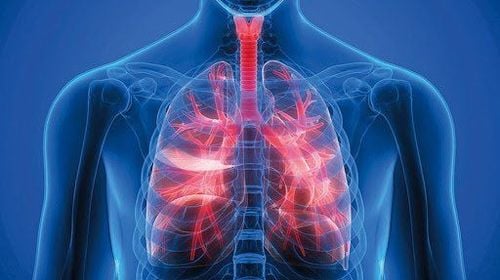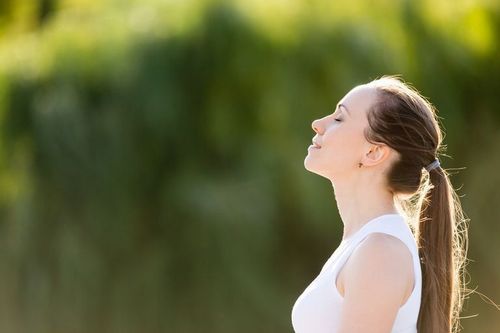This is an automatically translated article.
Breathing is an unconscious process. However, there are several optimal breathing practices that have the important benefits of breathing properly. This article looks at what happens inside a person's body when they breathe, and also provides instructions for breathing better and exercises for breathing properly. These are usually suitable for people with respiratory problems and those who don't.1. What is proper breathing?
Proper inhalation and exhalation is understood when our breathing is always at a regular, steady and controlled level. You will feel relaxed if you breathe properly and get enough oxygen without making your body work as much. Breathing properly will make us feel easy to breathe and the breath comes out gently and quietly. Your abdomen will expand with each inhale and contract with each exhale. You can also feel your ribs expand in front, sides, and after each inhale.Although breathing is a natural process, some people may be surprised to learn that there is a right way to breathe and a wrong way to breathe. The American Lung Association (ALA) offers the following advice on how to breathe properly:
Use your nose: Breathing through your nose can slow breathing and make your lungs work more efficiently. It also facilitates the absorption of nitric oxide and helps transport oxygen throughout the body. Breathing through the nose will also allow the nostrils to:
Filter toxins and allergens from the air and thereby prevent them from entering the body Helps warm the air Helps humidify the air However, double mouth breathing as needed if a person is exercising or has sinus congestion. Belly breathing: The most effective way to breathe is to bring air down to the abdomen. When your diaphragm contracts, your abdomen expands to fill your lungs with air. “Belly breathing” works because it pulls the lungs down, creating negative pressure inside the ribcage. This makes it easier to get air into the lungs.
Anatomy of breathing
Diaphragm is the main muscle used for breathing. It is a dome-shaped muscle located below the lungs, separating the chest cavity from the abdominal cavity. Our diaphragm constricts when we inhale, allowing our lungs to expand and increasing space in our chest. The intercostal muscles also help create space in the ribcage by contracting to pull our rib cage up and out as we inhale. The breathing muscles located near the lungs are responsible for helping the lungs to expand and contract steadily with each breath. These muscles include:
Abdominal muscles Diaphragm Intercostal muscles Muscles in the neck and collarbone area Lungs and blood vessels that carry oxygen to parts of the body and remove carbon dioxide. The airways transport oxygen-rich air into the lungs and carbon dioxide out of the lungs. The functional organs of the respiratory tract include:
The bronchial tubes (bronchi), their branches The larynx Oral Nose and the nasal cavity Trachea Effective use of the respiratory system will ensure that we can breathe well and reach maximum capacity.

Thở bằng mũi giúp cho phổi hoạt động hiệu quả hơn
2. A guide to breathing better
2.1. Diaphragm breathing practice
There are several diaphragmatic breathing exercises and techniques that we can do at home. This will help you learn how to use your diaphragm properly. It is best to do this technique when you feel rested and relaxed. Regularly practicing these methods of diaphragmatic breathing can help us:Reduce the amount of oxygen needed Slow down breathing to make breathing easier Strengthens the diaphragm Less strain on breathing, as well as use less energy during breathing Always talk to your doctor before starting any breathing exercise, especially for people with any medical condition that affects breathing or use a certain drug.
Diaphragm breathing exercises can be done at home. For beginners, try to do about 5 to 10 minutes of this exercise 3 to 4 times per day. You may get tired of doing this exercise because it takes more effort to use your diaphragm correctly. But when you get used to diaphragmatic breathing, it will feel more natural and easier to do. Slowly increase the amount of time you exercise each day. You can also place a book on your belly to increase the difficulty of the exercise or to help you focus more.
Diaphragm breathing exercise while lying down:
Lie on your back with your knees bent and an extra pillow under your head. Put an extra pillow under the knee to support the leg. Place one hand on your upper chest and the other under your ribs so you can feel the movement of your diaphragm. Inhale slowly through your nose, feeling your abdomen stretch against your hands. Keep your hand on your chest as still as possible. Engage your abdominal muscles and pull them toward your spine as you exhale by pursed lips. Again, keep your hands on your upper chest as much as possible. Continue breathing like this for the duration of the exercise. Once we have mastered the technique of diaphragmatic breathing while lying down, we can try this technique while sitting in a chair. This is a bit more difficult.
Diaphragm breathing exercise in a chair :
Sit in a comfortable position with your knees bent. Relax your shoulders, head and neck. Place one hand on your upper chest and the other below your rib cage so you can feel the movement of your diaphragm. Inhale slowly through your nose so that your belly is close to your hands. Keep your hand on your chest as still as possible. Engage your abdominal muscles as you exhale by pursing your lips and keeping your hands on your chest. Continue breathing like this for the duration of the exercise. Once you're comfortable with both of these poses, you can try incorporating diaphragmatic breathing into your daily activities. Practice this breathing technique when you:
Exercise Walk Climb stairs Carry or lift things Shower.

Nên thở bằng cơ hoành khi cảm thấy được nghỉ ngơi và thư giãn
2.2. How does the weather affect our breathing?
Our breathing is also affected by air quality, sudden weather changes or extreme weather conditions. While these changes may be noticeable to someone with respiratory illnesses, they can affect everyone. You may find that you breathe easier in certain weather or temperature conditions.Hot and humid weather can affect the body's respiratory process. This may be because breathing in hot air has been shown to cause airway inflammation and worsen respiratory conditions. Hot and humid weather also affects people with asthma, because inhaled air constricts the airways. Add to that air pollution during the summer months.
During humid weather and summer, the Lung Association in Canada recommends drinking plenty of water, staying indoors if you can be in an air-conditioned space with good air quality, and taking precautions. That means we have to know what our warning signs are if you have a condition like asthma or chronic obstructive pulmonary disease and check air quality indicators.
The dry, cold air that often accompanies frigid weather can also affect our lungs and the way we breathe. Dry air, regardless of temperature, often aggravates the respiratory symptoms of people with lung disease. Typically wheezing, coughing, and shortness of breath. To breathe easier in cold or very dry conditions, consider wrapping a towel around your nose and mouth. This can warm and humidify the air we breathe.
2.3. 7 tips to breathe better
There are several things we can do to improve our breathing. Here are some ways that can make you breathe easier and more efficiently:Adjust your sleeping position. Sleeping position can also affect our breathing. You can try sleeping on your side, resting your head on a pillow and between your legs. This helps keep our spines in a straight position, thus helping to keep the airways clear and possibly preventing snoring. Or you can sleep on your back with your knees bent. Place a pillow under your head and knees. However, sleeping on your back can cause your tongue to block your airway. This position is not recommended for people with sleep apnea or snoring. Consider lifestyle changes. Keep your lungs healthy by making positive lifestyle changes. Maintain a healthy weight and eat nutritious foods, including foods rich in antioxidants. Get flu shots and pneumonia vaccines to help prevent lung infections and improve lung health. Limit smoking, inhaling secondhand smoke and environmental irritants. Improve indoor air quality by using an air filter and reducing irritants such as artificial fragrances, mold, and dust. Positive thinking. Regular meditation has been shown to regulate breathing. This can be as simple as taking time to focus on your breath without trying to control it. Other benefits of positive thinking can include mental clarity, psychological well-being and less stress. Always maintain the correct posture during all activities. Maintaining correct posture during all activities helps to ensure that our chest and thoracic spine area can fully expand. The rib cage and diaphragm will also be able to fully extend and increase the range of motion in the front of your body. Overall, by maintaining the correct posture, we will be able to breathe more efficiently, making it easier for you to perform both daily and other physical activities. Sing often. You may also consider participating in singing activities to improve breathing and improve lung function. People with chronic obstructive pulmonary disease (COPD) have been shown to experience less shortness of breath and better control of symptoms if they sing regularly. They also found it easier to control their breathing. Singing activities help people with lung disease breathe more slowly and deeply as well as strengthen the muscles of the respiratory system. The British Lung Foundation recommends singing regularly to improve breathing, improve posture, and increase voice and diaphragm strength. Exercises to strengthen the respiratory muscles. Take steps to relieve tension in your shoulders, chest, and back. You can do exercises that focus on flexibility, resistance, and stretching to improve posture. This can allow you to fully expand your chest in all directions as you breathe. You can do stretching or massage to help loosen up your breathing muscles. You should also participate in activities to stay active. These include swimming, boating, or any activity that gets you moving. There are many different breathing techniques that we can practice. Doing these exercises regularly can help increase your awareness and control of your own breathing. You can get other benefits from breathing exercises like feeling deeply relaxed, sleeping better and feeling full of energy. Examples of breathing exercises include:
Rhythmic breathing techniques 4 – 7 – 8 Breathing through the nostrils Coordinated breathing Deep breathing Rib stretch It is natural for many people to breathe in order to maintain energy live for the body and it may not be something they give much thought to. There are many body parts involved in respiration. Therefore, some postures and ways of breathing are more effective for comfortable breathing than others. Practicing different breathing techniques can help increase the effectiveness of your breathing. For some people with chronic lung conditions, incorporating this awareness into their daily routine can help improve their breathing and, as a result, daily activities.
Please follow the website ( www.vinmec.com ) for more information on health care instructions, which we will update regularly.
Please dial HOTLINE for more information or register for an appointment HERE. Download MyVinmec app to make appointments faster and to manage your bookings easily.
Reference sources: healthline.com, medicalnewstoday.com



